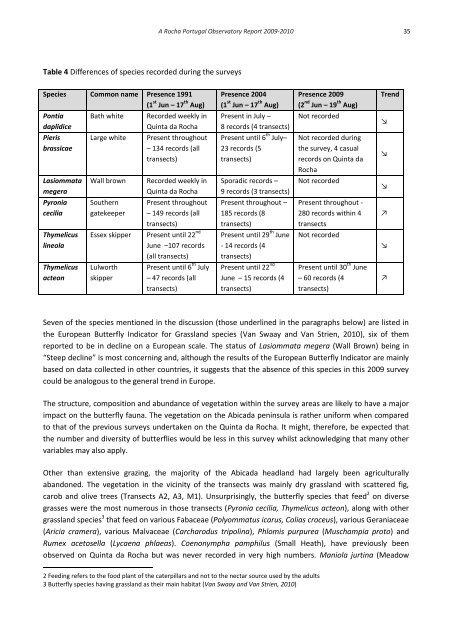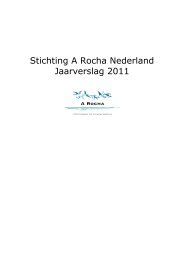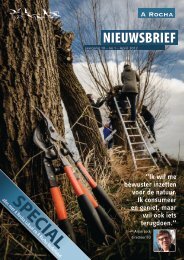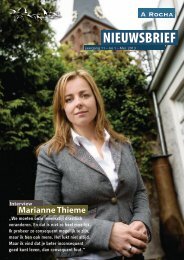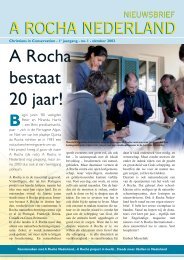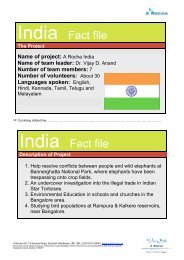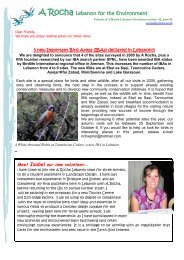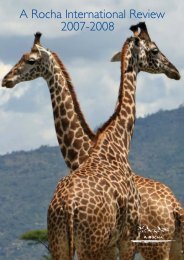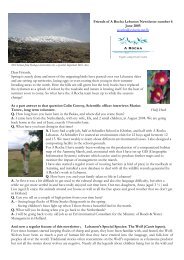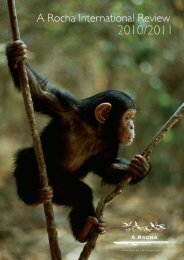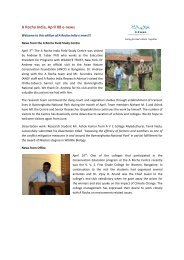A Rocha Portugal Observatory Report 2009-2010
A Rocha Portugal Observatory Report 2009-2010
A Rocha Portugal Observatory Report 2009-2010
Create successful ePaper yourself
Turn your PDF publications into a flip-book with our unique Google optimized e-Paper software.
Table 4 Differences of species recorded during the surveys<br />
Species Common name Presence 1991<br />
(1 st Jun – 17 th Aug)<br />
Pontia<br />
daplidice<br />
Pieris<br />
brassicae<br />
Lasiommata<br />
megera<br />
Pyronia<br />
cecilia<br />
Thymelicus<br />
lineola<br />
Thymelicus<br />
acteon<br />
Bath white Recorded weekly in<br />
Quinta da <strong>Rocha</strong><br />
Large white Present throughout<br />
– 134 records (all<br />
transects)<br />
Wall brown Recorded weekly in<br />
Quinta da <strong>Rocha</strong><br />
Southern<br />
gatekeeper<br />
A <strong>Rocha</strong> <strong>Portugal</strong> <strong>Observatory</strong> <strong>Report</strong> <strong>2009</strong>-<strong>2010</strong> 35<br />
Present throughout<br />
– 149 records (all<br />
transects)<br />
Essex skipper Present until 22 nd<br />
Lulworth<br />
skipper<br />
June –107 records<br />
(all transects)<br />
Present until 6 th July<br />
– 47 records (all<br />
transects)<br />
Presence 2004<br />
(1 st Jun – 17 th Aug)<br />
Present in July –<br />
8 records (4 transects)<br />
Present until 6 th July–<br />
23 records (5<br />
transects)<br />
Sporadic records –<br />
9 records (3 transects)<br />
Present throughout –<br />
185 records (8<br />
transects)<br />
Present until 29 th June<br />
- 14 records (4<br />
transects)<br />
Present until 22 nd<br />
June – 15 records (4<br />
transects)<br />
Presence <strong>2009</strong><br />
(2 nd Jun – 19 th Aug)<br />
Not recorded<br />
Not recorded during<br />
the survey, 4 casual<br />
records on Quinta da<br />
<strong>Rocha</strong><br />
Not recorded<br />
Present throughout -<br />
280 records within 4<br />
transects<br />
Not recorded<br />
Present until 30 th June<br />
– 60 records (4<br />
transects)<br />
Seven of the species mentioned in the discussion (those underlined in the paragraphs below) are listed in<br />
the European Butterfly Indicator for Grassland species (Van Swaay and Van Strien, <strong>2010</strong>), six of them<br />
reported to be in decline on a European scale. The status of Lasiommata megera (Wall Brown) being in<br />
“Steep decline” is most concerning and, although the results of the European Butterfly Indicator are mainly<br />
based on data collected in other countries, it suggests that the absence of this species in this <strong>2009</strong> survey<br />
could be analogous to the general trend in Europe.<br />
The structure, composition and abundance of vegetation within the survey areas are likely to have a major<br />
impact on the butterfly fauna. The vegetation on the Abicada peninsula is rather uniform when compared<br />
to that of the previous surveys undertaken on the Quinta da <strong>Rocha</strong>. It might, therefore, be expected that<br />
the number and diversity of butterflies would be less in this survey whilst acknowledging that many other<br />
variables may also apply.<br />
Other than extensive grazing, the majority of the Abicada headland had largely been agriculturally<br />
abandoned. The vegetation in the vicinity of the transects was mainly dry grassland with scattered fig,<br />
carob and olive trees (Transects A2, A3, M1). Unsurprisingly, the butterfly species that feed 2 on diverse<br />
grasses were the most numerous in those transects (Pyronia cecilia, Thymelicus acteon), along with other<br />
grassland species 3 that feed on various Fabaceae (Polyommatus icarus, Colias croceus), various Geraniaceae<br />
(Aricia cramera), various Malvaceae (Carcharodus tripolina), Phlomis purpurea (Muschampia proto) and<br />
Rumex acetosella (Lycaena phlaeas). Coenonympha pamphilus (Small Heath), have previously been<br />
observed on Quinta da <strong>Rocha</strong> but was never recorded in very high numbers. Maniola jurtina (Meadow<br />
2 Feeding refers to the food plant of the caterpillars and not to the nectar source used by the adults<br />
3 Butterfly species having grassland as their main habitat (Van Swaay and Van Strien, <strong>2010</strong>)<br />
Trend<br />
↘<br />
↘<br />
↘<br />
↗<br />
↘<br />
↗


